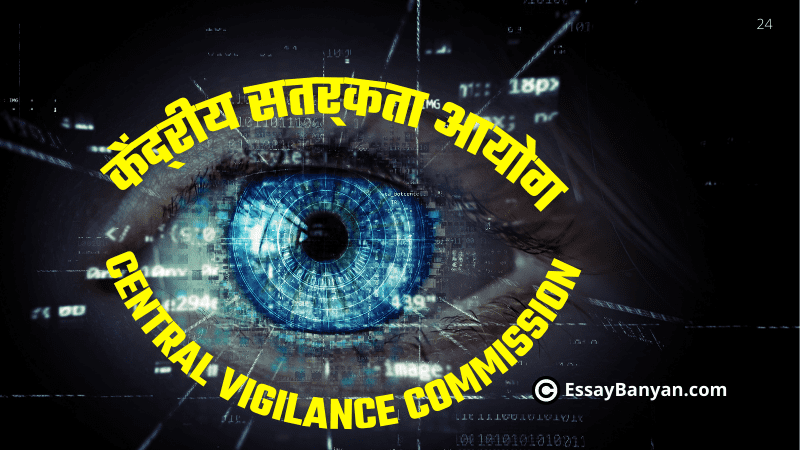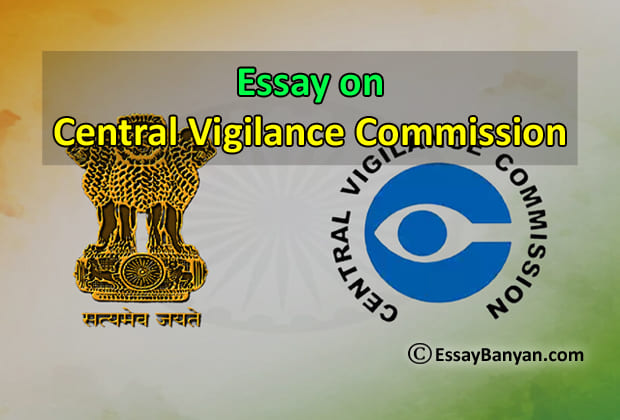The formation of governments in different countries of the world helps in the proper growth and development of the nation. The same government will not be able to function properly if corrupt practices are eminent at different levels. Thus, there is an organization or body formed in every nation to keep a check on such measures so that the functioning of the government in the nation is carried on smoothly. Have you heard the name of the Central Vigilance Commission? Yes, it is a body in India formed at the central level for keeping an eye on every vigilance activity in India. This is a very important topic for different competitive exams like UPSC, SPSC, SSC, etc.
Short and Long Essay on Central Vigilance Commission in English
A long essay on this topic has been provided below that contains an elaborate description of this topic. It will be an aid to all the exam aspirants, students, and readers in getting information about this topic. It will also aid the students of class 8-12th in getting an idea of writing an essay on this topic.
10 Lines Essay on Central Vigilance Commission (100-120 Words)
1) Central Vigilance Commission is responsible for monitoring government functionalities.
2) The biggest enemy of growth which is corruption raised the need for CVC.
3) Corruption in different government fields is monitored by CVC.
4) Central Vigilance Commission or CVC is an autonomous body.
5) It was 11 February 1964 Tuesday, when CVC was formulated.
6) Central Vigilance Commissioner is responsible for heading CVC.
7) The Central Vigilance Commission has a strength of 299 members.
8) The CVC is an advisory body rather than an investigatory body.
9) However, the advice of the CVC can be accepted or rejected by the departments.
10) In India, Vigilance Awareness Week is celebrated every year to reduce corruption.
1400 Words Essay on Central Vigilance Commission
Introduction
Corruption is the major cause of the decline of growth and development in countries like India. Vigilance is a necessary action to raise awareness to keep a watch on such activities. The proper vigilance helps the nation to fight against corruption in the government. This includes the misuse of government property, power, money, position, etc. Central Vigilance Commission is a monitoring body in India that helps in preventing corrupt practices at the central level. We will be discussing this body, its functions, composition, etc in detail in the essay provided below.
What is Central Vigilance Commission?
The central vigilance commission is an authority that is meant for preventing corruption in different departments at the central level in the government of India. This body is stated as an autonomous body that is free from control from any of the executive bodies in the nation. Central Vigilance Commission keeps a watch on every vigilance activity that is happening in the Government of India. It also instructs in the planning, executing, reviewing, and reforming of the vigilance works of the different authorities of the central government.
Establishment of Central Vigilance Commission
- The Central Vigilance Commission is the body working at the central levels and was instituted in the year 1964.
- It was formulated in an executive resolution of the government of India on the 11th of February in the year 1964.
- The Santhanam Committee on Prevention of Corruption recommended the establishment of this body. Shri K. Santhanam was the head of this committee. Initially, CVC was neither regarded as constitutional nor a statutory body.
- Central Vigilance Commission was given the statutory status after the CVC Act was passed in Parliament in the year 2003.
- The Central Vigilance Commission is regarded as an independent body and is only answerable to the parliament of India.
Organizational Structure of Central Vigilance Commission
- Central Vigilance Commission is a body that is constituted of different members. The body is administered by the Central Vigilance Commissioner. The Central Vigilance commissioner gets assisted by two vigilance commissioners.
- The CVC is an autonomous body that has its own secretariat, the Chief Technical Examiner’s wing of Commissioners for Departmental Inquiries.
- The Central Vigilance Commission has 299 members sanctioned strength. This strength includes the Central Vigilance Commissioner and two Vigilance Commissioners.
Appointment of Members of CVC
- The President of India appoints the Central Vigilance Commissioner and Vigilance Commissioners.
- The President of India appoints them on the recommendation of the committee formed by the Prime Minister, Home Minister, and the Leader of Opposition in Lok Sabha.
- The salary and allowances of the Central Vigilance Commissioner is the same as that of the chairman of UPSC and that of the Vigilance Commissioner is similar to that of members of UPSC.
Tenure- The tenure of the appointed members is of four years or 65 years age, whichever comes earlier.
Removal of the Members:
- The members of the Central Vigilance Commission can only be removed from their position by the President of India after the misbehavior or incapacity is proved by the Supreme Court.
- The Vigilance Commissioners can be suspended or ordered not to attend the office till the inquiry period on the orders of the president.
- The Vigilance Commissioner can also be removed by the President if he is found to be involved in acts of criminal activities or dishonesty, engages in any other paid employment along with government duty, is physically unfit, has been found involved in other interests.
Role/Functions of Central Vigilance Commission
Central Vigilance Commission is not stated as an investigating agency but it is an advisory body that keeps a watch on civil works of the government. The investigation by this statutory body against any government official can only be carried out after permission from the government. There are several powers vested in this central body. The functions and power of the Central vigilance commission are enlisted below:
- Central Vigilance Commission does not investigate by itself but monitors all the vigilance activities under the central government. It refers to all the complaints received to the Central Bureau of Investigation or Ministry of Investigation for investigation of the cases.
- It instructs different government departments in planning, executing, and reforming their vigilance work.
- It receives different complaints regarding corruption, misconduct, lack of integrity, and different malpractices by different officials in the departments at the central level. It advises and suggests the action that has to be taken.
- The complaints can be registered by Lokpal, the central government, and Whistleblowers.
- An annual report is presented by CVC every year to the government that elaborates the work done by the CVC throughout the year. It also specifies the system failure in the departments that resulted in corruption, highlights the cases where the advice of the commission was ignored, and also suggests different methods by which corruption can be reduced.
Purpose of Central Vigilance Commission
The Central Vigilance Commission has been formed in India to keep a check on the corruption activities taking place in different central departments in the nation. This body works with a vision to stop the corrupt practices that directly or indirectly inhibit the growth and progress of the nation. CVC needs the permission of the government to take action after investigation of any corrupt activity that is taking place at the central level.
Limitations of Central Vigilance Commission
- There are certain restrictions of the Central Vigilance Commission and that have been enlisted below:
- The Central Vigilance Commission is not stated as an investigating agency and thus it has its role only as an advisory body.
- The CVC has the function to advise the central government departments but these departments have freedom either to reject or accept the advice of CVC in corruption cases.
- The CVC is directed to keep an eye on vigilance activity in more than 1500 departments of central government and the strength of the CVC is not sufficient as it is only of 299 members. Moreover, the resources that they have are not sufficient with respect to the complaints.
- The CVC does not have the power of directing CBI to conduct inquiries on the officers of the level of Joint Secretary.
- CVC can only advise in vigilance and disciplinary cases but does not have the power to register the criminal cases.
- CVC is regarded as a supervising authority over CBI but it does not have any control over CBI in reality.
- CVC is no doubt an autonomous advisory body but due to inadequate power and resources it is unable to take action on corruptions taking place in the different government departments in the nation.

The Concept of Vigilance Awareness Week
It is an idea that has been proposed and brought into action by the Central Vigilance Commission. The last week of October every year is celebrated as Vigilance Awareness Week in India. The birthday of the Iron man of India named Sardar Vallabhbhai Patel also falls in the same week. This week is celebrated to make people aware of the corrupt practices that are taking place in the nation. Corruption is the major hindrance to the way of growth and progress of the nation. The celebration of this week aims to reduce the level of corruption in the nation and make it a new India till the year 2022.
Vigilance Awareness Week – 2021
Vigilance Awareness Week is celebrated every year in India. There is a provision of celebrating this week with a theme of the week. The theme of Vigilance Awareness Week-2021 theme was “Self Reliance with self-integrity”. The different organizations and departments participate in making this program a successful one. Several activities like seminars, debates, activities are organized throughout the nation by different public and private organizations.
Conclusion
There are several developments in different sectors that have taken place in the nation after India got independent. The surplus growth and progress of different sectors contribute to the growth of the entire nation. Corruption is acting like a pest that affects the development of the nation. The authorities like CVC in India must be given full power and enough resources so that they may be able to act accordingly. The reduction in corruption level in India can help the nation to excel in different fields and this can happen only if the drawbacks of the Central Vigilance Commission are addressed. I have tried to make this essay a simple one by writing it in easy language.
I hope that the essay will be helpful to all the students and readers in giving them a brief idea about Central Vigilance Commission.
Related Link :
- Essay on Cryptocurrency and Issues Related To It
- Essay on Blockchain
- Essay on Internet of Things (IoT)
- Essay on Hyperloop
FAQs: Frequently Asked Questions on Central Vigilance Commission
Ans. Central Vigilance Commission is the major organization for stopping corruption in India.
Ans. Central Vigilance Commission is an advisory body in the government of India.
Ans. Nitoor Srinivasa Rau was appointed as the first chief Vigilance Commissioner of India.
Ans. CVC was given the status of statutory body in the year 2003.
Ans. There are three members in the committee formed for appointing the members of CVC.
Ans. Suresh N. Patel is the present chairman of the Central Vigilance Commission.

